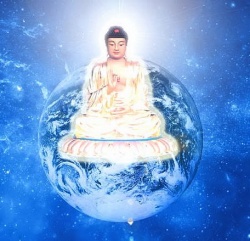Difference between revisions of "Seven Treasures"
| (9 intermediate revisions by 2 users not shown) | |||
| Line 1: | Line 1: | ||
| − | Ies4peace3.jpg | + | [[File:Ies4peace3.jpg|thumb|250px|]] |
| + | |||
| + | |||
| + | |||
| + | |||
| + | |||
| + | |||
| + | |||
| + | |||
<poem> | <poem> | ||
| − | '''seven treasures''' (七寶). | + | '''[[seven treasures]]''' ([[七寶]]). [[Seven Treasures]] [[Gold]], {{Wiki|silver}}, [[lapis lazuli]], {{Wiki|crystal}}, {{Wiki|agate}}, [[Wikipedia:Ruby|red pearl]] and {{Wiki|carnelian}}. They represent the [[seven powers of faith]], perseverance, [[sense of shame]], avoidance of wrongdoing, [[mindfulness]], [[concentration]] and [[wisdom]]. |
| − | These are | + | |
| − | (1) suvarṇa (金, gold); | + | |
| − | (2) rūpya (銀, silver); | + | |
| − | (3) vaiḍūrya (琉璃, aquamarine); | + | These are ; |
| − | (4) sphaṭika (頗梨, crystal); | + | |
| − | (5) musāragalva (硨磲, conch shell or white coral); | + | |
| − | (6) lohita-muktikā (赤珠, ruby); and | + | (1) [[suvarṇa]] ([[金]], {{Wiki|gold}}); |
| − | (7) aśmagarbha (瑪瑙, emerald). | + | (2) [[Wikipedia:silver|rūpya]] ([[Wikipedia:silver|銀]], {{Wiki|silver}}); |
| + | (3) [[Wikipedia:aquamarine|vaiḍūrya]] ([[Wikipedia:aquamarine|琉璃]], {{Wiki|aquamarine}}); | ||
| + | (4) [[Wikipedia:crystal|sphaṭika]] ([[Wikipedia:aquamarine|頗梨]], {{Wiki|crystal}}); | ||
| + | (5) [[musāragalva]] ([[Wikipedia:crystal|硨磲]], [[conch shell]] or white {{Wiki|coral}}); | ||
| + | (6) [[Wikipedia:ruby|lohita-muktikā]] ([[Wikipedia:ruby|赤珠]], {{Wiki|ruby}}); and | ||
| + | (7) [[Wikipedia:emerald|aśmagarbha]]([[Wikipedia:emerald|瑪瑙]], {{Wiki|emerald}}). | ||
| + | |||
| + | |||
| + | |||
| + | Sometimes {{Wiki|coral}} and {{Wiki|amber}} are included in place of {{Wiki|crystal}} and {{Wiki|ruby}}. F. {{Wiki|Max Müller}} cites a reference in [[Buddhist]] [[Mahāyāna Texts]] (Cowell et al. [1894] 1969, part 2, 92), in which [[vaiḍūrya]] is matched with [[lapis lazuli]], and [[aśmagarbha]] with | ||
| + | |||
| + | [[diamond]]. While [[lapis lazuli]] is an opaque intense blue stone, indications in the [[sūtras]] are that [[vaiḍūrya]] should be a transparent [[blue beryl]], such as {{Wiki|aquamarine}}. According to the {{Wiki|Monier-Williams}} Online {{Wiki|Dictionary}}, [[aśmagarbha]] is {{Wiki|emerald}}; [[vajra]] ([[伐折羅]]) is [[diamond]], an [[adamantine]] mineral ([[金剛]]) | ||
| + | |||
| − | |||
</poem> | </poem> | ||
{{R}} | {{R}} | ||
[http://www.sutrasmantras.info/glossary.html#faculty www.sutrasmantras.info] | [http://www.sutrasmantras.info/glossary.html#faculty www.sutrasmantras.info] | ||
| − | |||
[[Category:Buddhist Symbols]] | [[Category:Buddhist Symbols]] | ||
| + | {{BuddhismbyNumber}}{{BuddhismbyNumber}} | ||
Latest revision as of 16:14, 5 January 2024
seven treasures (七寶). Seven Treasures Gold, silver, lapis lazuli, crystal, agate, red pearl and carnelian. They represent the seven powers of faith, perseverance, sense of shame, avoidance of wrongdoing, mindfulness, concentration and wisdom.
These are ;
(1) suvarṇa (金, gold);
(2) rūpya (銀, silver);
(3) vaiḍūrya (琉璃, aquamarine);
(4) sphaṭika (頗梨, crystal);
(5) musāragalva (硨磲, conch shell or white coral);
(6) lohita-muktikā (赤珠, ruby); and
(7) aśmagarbha(瑪瑙, emerald).
Sometimes coral and amber are included in place of crystal and ruby. F. Max Müller cites a reference in Buddhist Mahāyāna Texts (Cowell et al. [1894] 1969, part 2, 92), in which vaiḍūrya is matched with lapis lazuli, and aśmagarbha with
diamond. While lapis lazuli is an opaque intense blue stone, indications in the sūtras are that vaiḍūrya should be a transparent blue beryl, such as aquamarine. According to the Monier-Williams Online Dictionary, aśmagarbha is emerald; vajra (伐折羅) is diamond, an adamantine mineral (金剛)
